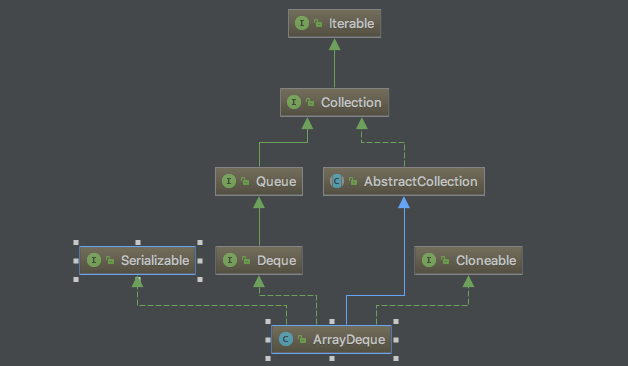背景
前几篇主要介绍的都是java的普通集合,包括list,set,map等 本篇要介绍和ArrayList对应的ArrayDeque
上一篇和Deque相关的实现时LinkedList。之前提到过LinkedList既是List也是Queue
源码
类图

构造函数
/** * Constructs an empty array deque with an initial capacity * sufficient to hold 16 elements. */ public ArrayDeque() { elements = (E[]) new Object[16]; } /** * Constructs an empty array deque with an initial capacity * sufficient to hold the specified number of elements. * * @param numElements lower bound on initial capacity of the deque */ public ArrayDeque(int numElements) { allocateElements(numElements); }
ArrayDeque顾名思义是一个用数组实现的双向队列。
其默认大小为16【当调用无参构造函数时】
而会通过AllocateElements来进行确保size为2的倍数
private void allocateElements(int numElements) { int initialCapacity = MIN_INITIAL_CAPACITY; // Find the best power of two to hold elements. // Tests "<=" because arrays aren't kept full. if (numElements >= initialCapacity) { initialCapacity = numElements; initialCapacity |= (initialCapacity >>> 1); initialCapacity |= (initialCapacity >>> 2); initialCapacity |= (initialCapacity >>> 4); initialCapacity |= (initialCapacity >>> 8); initialCapacity |= (initialCapacity >>> 16); initialCapacity++; if (initialCapacity < 0) // Too many elements, must back off initialCapacity >>>= 1;// Good luck allocating 2 ^ 30 elements } elements = (E[]) new Object[initialCapacity]; }
其实就是保证为2的倍数
这段代码就是将左边最高位循环传递给右边 先传1 此时至少最高位和次高位为11 再次循环右传递 此时至少最高4位为1 一次反复直到32位【最高位到末尾】全部为1
这个时候执行+1的操作自然需要进位此时 就完成了2的pow操作 如果溢出需要向右右移
相比较下还是
// Find a power of 2 >= initialCapacity int capacity = 1; while (capacity < initialCapacity) capacity <<= 1;
容易理解【但是效率可能没有上面的算法高~大数的情况下】
那我们已知就是正常情况下使用ArrayDeque时16的size
由于是双向队列,通常来说需要使用环形来解决
如何判断队列是否是满呢?
【通常思路是两个指针分别指向头和尾 当向头部插入元素是头指针后移 当向尾部插入元素是尾指针前移,如果头指针和尾指针相遇表示队列已满】===》并不存在严格意义上的满,ArrayDeque会自动扩容 因此属于无界非阻塞队列
addFirst
/** * Inserts the specified element at the front of this deque. * * @param e the element to add * @throws NullPointerException if the specified element is null */ public void addFirst(E e) { if (e == null) throw new NullPointerException(); elements[head = (head - 1) & (elements.length - 1)] = e; if (head == tail) doubleCapacity(); } /** * Double the capacity of this deque. Call only when full, i.e., * when head and tail have wrapped around to become equal. */ private void doubleCapacity() { assert head == tail; int p = head; int n = elements.length; int r = n - p; // number of elements to the right of p int newCapacity = n << 1; if (newCapacity < 0) throw new IllegalStateException("Sorry, deque too big"); Object[] a = new Object[newCapacity]; System.arraycopy(elements, p, a, 0, r); System.arraycopy(elements, 0, a, r, p); elements = (E[])a; head = 0; tail = n; }
当插入元素时必然要先检查是够为空为空则直接抛出异常【如果允许插入了空元素当移除的时候碰到null无法区分是否是一个真实的元素,当然也可以同EnumMap的方式使用Object来做mask】
正如上文所说当head == tail表示插入已满 那么需要做扩容【扩容都是两倍】===》为何要求数组的长度为2的倍数?需要通过
(elements.length - 1)进行与操作来保证 由于element.length为2的pow 因此减一自然可以获得全是除首位之后全是1 那么可以轻而易举的获得在size之类的数组下标
扩容的时候每次也是两倍大小的扩容,在做数组元素copy是直接从头指针指向地方开始拷贝 这样不需要重新计算头尾指针 直接将头指针设置为0尾指针设置为之前数组的长度
pollFirst
public E pollFirst() { int h = head; E result = elements[h]; // Element is null if deque empty if (result == null) return null; elements[h] = null; // Must null out slot head = (h + 1) & (elements.length - 1); return result; }
当移除first时直接将对应头指针的返回即可,同时标记头指针指向的数组元素为空 同时移动头指针


